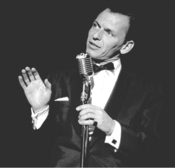Sinatra: Master of The Divine Couplet Of Singing Pt. 2
 Gary Catona Posted on
Gary Catona Posted on  Wednesday, May 8, 2013 at 03:43PM
Wednesday, May 8, 2013 at 03:43PM  Very early in his career, Sinatra rarely sang in the down, back, and open oo and ee positions and this is why his voice could sound light, thin, and nasal. Thin, nasalized vowel sounds are signs that a singer’s vocal musculature—in the larynx and pharynx—is not sufficiently involved in forming vowel sounds. It also means that the larynx is resting too high in the throat—and the soft palate relaxing too low—to allow for their deep-throated formation; a forward-sounding voice is the natural consequence. Sinatra’s young, unformed voice was, in this sense, open vowel-sound deficient, and is one reason why he often crooned, Bing Crosby style, when he performed rather than sing out—and back and down—in a full-throated fashion.
Very early in his career, Sinatra rarely sang in the down, back, and open oo and ee positions and this is why his voice could sound light, thin, and nasal. Thin, nasalized vowel sounds are signs that a singer’s vocal musculature—in the larynx and pharynx—is not sufficiently involved in forming vowel sounds. It also means that the larynx is resting too high in the throat—and the soft palate relaxing too low—to allow for their deep-throated formation; a forward-sounding voice is the natural consequence. Sinatra’s young, unformed voice was, in this sense, open vowel-sound deficient, and is one reason why he often crooned, Bing Crosby style, when he performed rather than sing out—and back and down—in a full-throated fashion.




